On your day to day travels about town, have you ever had an epiphanic moment – an instant when you’ve seen something as you’ve never seen it before? Bryan Appleyard writes about this in his book, The Brain is Wider than the Sky. He talks of the concept of ‘vuja de’ – when we notice something we may have seen or known, yet feel we are encountering for the first time. We gain a new perspective, a sudden flash of inspiration.
I had one of those moments the other day, when I parked my car in a narrow side street in Southwark. Ever since building started on The Shard, I’ve been taking regular photographs of its progress, from various vantage points – but mainly from Southwark Street, alongside Borough Market.
Then I saw The Shard as if for the first time, rising above a large rusting iron gate, which was completely covered in coloured ribbons, silk flowers, cuddly toys, beads and gaudily printed notes.
A bronze plaque reads:
In medieval times this was an unconsecrated graveyard for prostitutes or ‘Winchester Geese’ By the 18th century it had become a paupers’ burial ground, which closed in 1853. Here, local people have created a memorial shrine. The Outcast Dead R.I.P
A quick search on the web showed that this is the site of the Cross Bones Graveyard. ‘Winchester Geese’ were prostitutes licensed by the Bishop of Winchester to ply their trade in Southwark’s Liberty of the Clink. And the 18th century paupers’ burial ground was known as The Mint, a notorious slum and thieves’ quarter.
London Underground dug up part of the site during the Jubilee Line Extension in the 1990s, removing some 148 skeletons. Then in 1996, a self-proclaimed urban shaman called John Crow began “channelling the spirit of The Goose at Cross Bones.” This was documented in a book, The Southwark Mysteries, penned by Crow’s alter-ego, John Constable. The shrine was established in 1998, when Southwark Mysteries staged the first Halloween of Cross Bones, a ritual honouring the outcast dead. The ribbons bear the names of people buried on the site.
The Friends of the Cross Bones have worked to influence the site owners, Transport for London (TfL), to rededicate part of the site as a garden of remembrance. Southwark Council funded the bronze plaque and ivy planters and pledged £100,000 from its Community Project bank towards a future garden. The northern part of the site is being used as a Thameslink works site and temporary car-park, fenced off from the old graveyard site to the south, which is already a wild garden.
However, the Cross Bones website explains that Drivers Jonas Deloitte, acting on behalf of TfL, are currently marketing the entire site as ‘Landmark Court’ for potential development from 2012. It adds that Cross Bones is estimated by the Museum of London to contain up to 15,000 burials, more than half of them children. And says, “we ask that any future developments should protect the graveyard area as a public park – the Cross Bones Garden of Remembrance – and maintain the gates in Redcross Way, which were long ago transformed into a people’s shrine.”
The Shard’s website bears the strapline ‘inspiring change.’ It’s as if the monumental landmark has become a 21st century Skylon – a futuristic, Utopian symbol – a gigantic boost to Britain’s skyline in a time of austerity. Seeing the jumble of kitsch offerings on Cross Bones memorial gate, in the shadow of the towering metal and glass spike (that, to many, signifies progress), made me reflect on the important things at ground level. Things we would be ill-advised to overlook at any time: Our history, our heritage, and above all our fellow human beings.

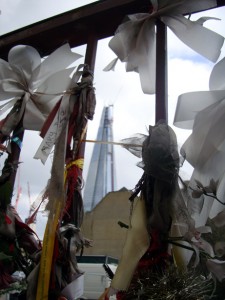

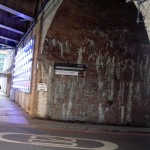
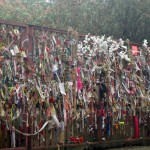
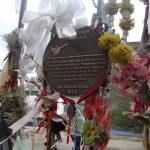
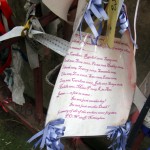
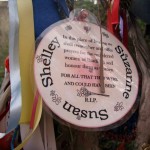
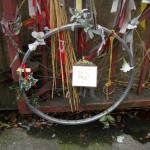
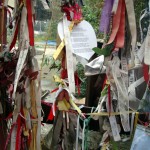
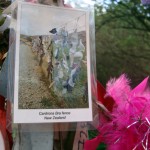

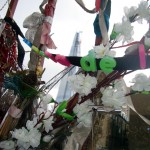
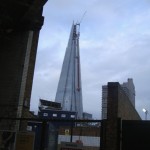
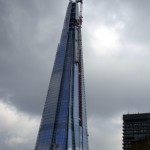
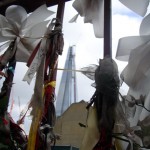








The Cross Bones Graveyard is just around the corner from the ResonanceFM studio on Borough High Street, and I often pay a brief contemplative visit on the way to or from my show.
While in no way wishing to diminish your post, I fear a nit must be picked. Not your error, but unfortunately one made by those who put up the bronze plaque. A Winchester goose was never a prostitute, but, at the time, her all-too-likely stock-in-trade: a venereal bubo, as passed on to a luckless client. Thus John Taylor (who has appeared here as a Slang Hero): in ‘Taylors Goose’ (1630): Then ther’s a Goose that breeds at Winchester, / And of all Geese, my mind is least to her: / For three or foure weekes after she is rost, / She keepes her heat more hotter than a tost. / […] / From Fornication and Adultery, / From reeking Lust, foule Incest, beastle Rape, / She hath her birth, her breeding, and her shape.’ Thus too the phrase ‘nipped by a Winchester goose’, i.e. poxed and the 17th century catchphrase used by contemporary whoremongers and referring to a well-known woman of the town: ‘No Goose bit so sore as Bess Broughton’s.’
What a silly goose, I knew I should have consulted you before I embarked upon this post, Jonathon – thanks for shedding more light on this ancient idiom – might it be responsible for the ‘goose step’?
Nice thought. The OED is singularly uninformative, insofar as it offers no etymology, so maybe we have no choice but to equate the step with the bird. What is perhaps interesting is that Brits seem to have always instinctively disliked it. The first recorded use runs thus:
1806 R. Wilson Jrnl. 11 Feb., The balance or goose-step introduced for their practice excites a fever of disgust.
The writer is an English general. ‘They’ appear to be Dutch troops in Cape Town.
A wonderful post: fascinating and moving; splendid photos; a link to The Shard, and just when I thought it couldn’t get any better, Jonathon Green adds a comment of sublime clarification. The one moment of confusion: ‘a venerable bubo’ had me googling. All became clear when a pop-up directed me to Specsavers….
My favourite ever retroprogressive saturday post! Wonderful stuff Susan, and great footnotes from Jonathon!
All those graveyards and plague pits around London fascinate me, especially the gruesome stories of the victoria line tunnel boring machines running into one at Green Park station…
Good stuff. I was on the South Bank briefly yesterday and I was struck by the intensity of building going on in the area behind the Tate, all these shiny new angular blocks topped by weird roof gardens brimming with trees… meanwhile, directly below are scattered old buildings with quaint gardens. Ancient fragments in the shadow of the new. I didn’t see this shrine but it makes sense that it’s there, and I’ll definitely make a point of going.
HaHa…Ive already been up it, just a few weeks ago in my orange all weather workwear, Blue gloves and red boots, you probably noticed me.
I had a pork sandwich with apple sauce and crackling and a flask of tea where the restaurant is going to be. Remember me when the bill comes for 150 quid for a cucumber sandwich. And I got a front row seat watching the new James bond movie being filmed at tower hill.
Not too bad from the top, but Emley moor is taller and ive been up that too and the view from there as its on a hill is beyond your expectations, and of course the view is Yorkshire (and more) not London.
The view IMO is best in the early evening rush hour, probably in the early and late winter when all the lights come on an there is still enough natural light to see the details behind the artificial lights. Because London is such a big city you dont feel separated from the ground as the whole city surrounds you. At the top of Emley moor you feel like you are flying.
It should be topped out soon and light up for the Olympics, I am told there are going to be lots of cameras feeds during the Olympics so I would get your curtains cleaned.
I’ve been to Ilkley Moor, Sean – is it similar?
From the top of my head (6.5) The Shard is 326 meters above sea level which is 1069.5 ft.
and Emley Moor mast is 1900 feet, the control room is a 100 feet or so below the top of the mast, again off the top of my head.
The Shard I think is 16 mts above sea level at its base, the river is running down hill except when they close the barrier and tidal flow.
Now Ilkley moor is at 1,319 ft above sea level, thus you are in fact at a higher elevation in Yorkshire, thus we win again.
And strangely enough the last bit of the Shard that is now up I believe, was put together a few weeks ago in a field in North Yorkshire as a dry run. So think of us when you visit the open air observation deck later in the year.
http://www.constructionenquirer.com/2011/11/16/shard-spire-built-in-yorkshire-field/
Jonathon had me googling too, John – thanks for the compliment – and worm… there’s a saying that you’re only as good as your last blog post, so perhaps I should throw in the towel now?
Ancient fragments in the shadow of the new – wish I’d thought of that phrase, Gareth!
Interesting post Susan, makes me want to visit the old haunts again, almost. The citizen art is absorbing, there should be more of it, (Liebesschlösser, lovelocks, on Köln’s Hohenzollern bridge.)
Although the multi-faceted finger, having writ, should really move on.
Bryan Appleyards latest is another thought provoker, well into the rap-hat category (read a page-have a think)
A wonderful post on the sort of thing that makes this city so endlessly fascinating and thought-provoking.